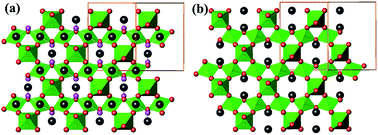The β-type pyrochlore CsTaWO6 was studied by synchrotron X-ray diffraction (XRD) and Raman scattering methods up to pressures of 43 GPa using a diamond anvil cell (DAC). With increasing pressure, the cubic pyrochlore in space group of Fd-![[3 with combining macron]](http://www.rsc.org/images/entities/char_0033_0304.gif) m transforms to an orthorhombic structure (space group: Pnma) at 5.9 GPa and then to a monoclinic structure (space group: P21/c) at ∼18 GPa. The structural evolution in CsTaWO6 is a continuous process and experimental results suggest that the initial cubic phase has a tetragonal distortion at ambient conditions. Both XRD and Raman measurements indicate that the pressure-induced phase transitions in CsTaWO6 are reversible. These results may provide a structural explanation of previous experimental resistivity measurement results for the isostructural superconductor K(Cs)Os2O6 at high pressure conditions.
m transforms to an orthorhombic structure (space group: Pnma) at 5.9 GPa and then to a monoclinic structure (space group: P21/c) at ∼18 GPa. The structural evolution in CsTaWO6 is a continuous process and experimental results suggest that the initial cubic phase has a tetragonal distortion at ambient conditions. Both XRD and Raman measurements indicate that the pressure-induced phase transitions in CsTaWO6 are reversible. These results may provide a structural explanation of previous experimental resistivity measurement results for the isostructural superconductor K(Cs)Os2O6 at high pressure conditions.

